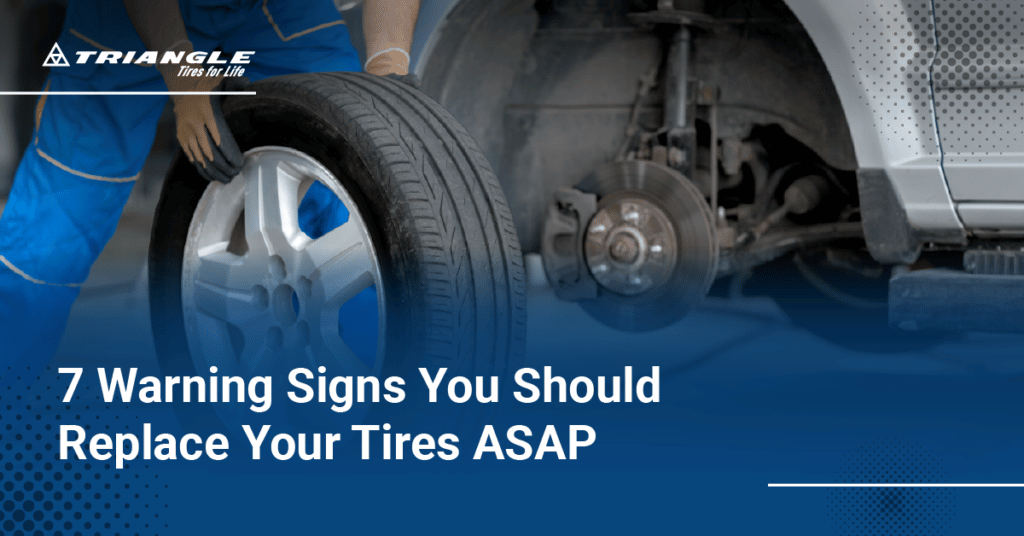
Did you know that car tires driven under normal service conditions wear out after three to four years? Upon reaching five to six years, tires need to undergo annual inspections. But after 10 years – regardless of their condition – those tires will need a replacement.
Since tires wear out over time, regular maintenance checks are essential to avoid serious mishaps. As such, every driver should know the common warning signs that indicate the car tires are no longer up to par.
This article will discuss the symptoms of bad tires and the telltale signs they need to be replaced.
When to Replace Tires: 7 Warning Signs You Should Look Out For
1. Bulges or blisters on the surface of the tire
When the sidewalls of the tires start developing bulges and blisters on their outer surface, that’s an indication your tires may be damaged. Tires with a tear or an irregular bump can make your car unsafe to drive. Air pockets caused by bulges point to weakened parts of the wheel. Once they blow out, you’ll have flat tires as a result.
So, if you see these signs, it’s best to replace your tires before heading out to avoid any driving accidents.
2. Tread wear indicator bars are the same height as the tread
Generally, tire tread depth should not fall under 1.6 millimeters. If you regularly drive on wet surfaces, the tread may wear down faster.
Fortunately, newer tire models have a tread wear indicator bar that shows how much damage the tire has accumulated. These indicators appear as flat rubber bars running across the direction of the tread. If one or two of these markings start to appear, it’s a clear indicator that your tire is running low on tread and should be replaced.
If you have older tire models, you can do the “Piso test” to determine if you have enough tire tread left. Simply insert a one-peso coin into the tread with the “head” portion facing upright. If the year just below the head section of the coin is partially covered, then you have enough tread.
Otherwise, buying new tires may be the next best course of action.
3. Air leaks
Air leaks may cause gradual deflation of your tires. Pounds per Square Inch (PSI) is the unit of measurement used to determine the air pressure inside your tires.
You may refer to your vehicle’s recommended PSI to determine if it’s a simple problem or a significant puncture. The ideal PSI for car tires ranges from 32 to 35 PSI, while heavier vehicles like trucks and buses will generally require a higher tire pressure of around 116 to 131 PSI.
If your PSI drops by one in a week, your tire may have a small repairable puncture or a bent rim that lifts the space between your wheel and tire. However, sudden drops in PSI should be a cause for concern, as they may indicate a large hole.
Carefully inspect the tires and look for debris, holes, or foreign objects around the tire’s surface. Then consult with a car professional if you find out it’s not just a simple patch job.
4. TPMS warnings
Your car’s tire pressure monitoring system (TPMS) warns you if one or more of your tires are severely under-inflated, which is deemed unsafe to drive. If your TPMS starts giving alerts but you’re suspicious it might be just defective, you can visit your nearest auto service center to find out the real problem.
While there, have them check your TPMS and your tires, as well. If the TPMS warning lights continue to flicker, the mechanic may suggest a more extensive inspection of your car systems.
5. Car shakes while driving
Car shaking or vibrating is normal, especially when you drive on bumpy roads. However, if you notice that the vibration persists, your tires may have a problem. Unbalanced or misaligned tires could cause these shaking issues. Additionally, your car’s shock absorbers may be broken, causing your tires to vibrate.
If your car constantly demonstrates these problems, it’s best to consult a professional mechanic and replace the defective tires.
6. Your tires are more than three years old
Most car owners jump to dire conclusions when their vehicles malfunction. However, sometimes the age of the tires has a lot to do with the problem.
Your tires should be checked at least once a year to ensure they are safe and in excellent condition. Again, regular checkups should be customary once your tires are more than three years old.
7. Changing weather conditions
Tires are constantly exposed to harsh weather conditions – from the extreme heat of the summer season to wet surfaces on rainy days – which can cause degradation. Rubber is a natural material and will start to break down over time, especially when it is subjected to weathering.
Common signs of weathering on your tires are cracks between the tread blocks and sidewall. If you notice that the internal materials are exposed to weather elements, it may be time to replace your tires immediately.
Don’t Get Tire(d)
Tires play an integral part in keeping you safe behind the wheel. It controls your steering, acceleration, and braking, as well as absorbs all bumps the road may throw at you. With the safety and security that tires bring, choosing quality tires for replacement jobs is essential. Prioritize tire durability to ensure you can use them for a long time.
If you’re looking for quality replacement tires, Triangle Tires can help. We have a wide array of tires, from passenger cars and light trucks to heavy equipment vehicles, available for delivery at an affordable price. In addition, we also offer a three-year warranty against factory defects from the date of purchase of your tires. Browse our tire catalog today and find the perfect set of wheels for your drive.